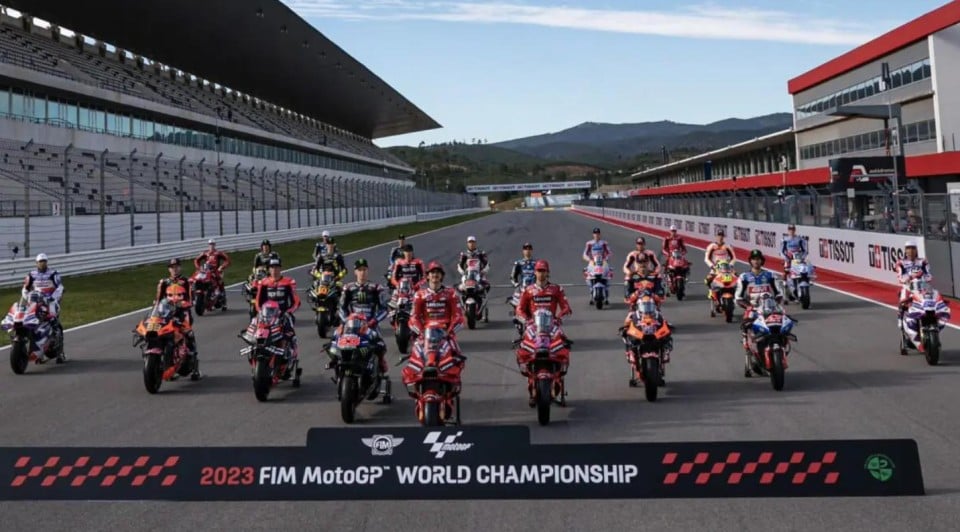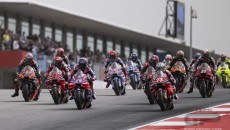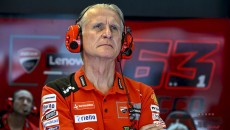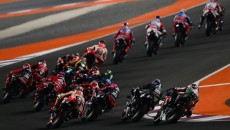Riders today are, in the vast majority of cases, toy soldiers. It's difficult to hear anything from them that isn't pertinent. The nasty infection of 'political correctness' has crept into motorcycling to such an extent that it has made most declarations boring.
Even in the rapport between them, very little emerges about the real relationships or antagonisms that bind or divide them.
We are not talking about the stances taken: to date the only thing everyone seems to agree on is criticizing Freddie Spencer, but no one thinks of asking who put him there or, worse, trying to undermine a structure which at the time was created for a completely different purpose. We're talking about IRTA, obviously.
Timidly, however, we sense a change taking place and it is linked to the uncontrolled increase of the number of Grand Prix races due to the constant search for ever greater profits.
A breaking point is determined by a sudden and unexpected increase in the workload, which is perfectly explained by this technical definition: by applying an external force or stress to a material, this will undergo a deformation and a change in the internal stress state due to the exchange of interaction of the molecules that compose it. By progressively increasing the external force, the internal tensions will balance it from time to time, but only up to a limit point beyond which this will no longer be possible: in this circumstance the material will break and the intensity value of the external force applied in that moment will be called load or breaking force.
Replacing the word 'material' with 'riders', it is clear that the sudden and disproportionate increase in the aforementioned load has not been one or two more Grands Prix over the course of the year, something that the protagonists of MotoGP would have put up with, but actually double the number of races due to the reckless introduction of Sprints in all world championship events.
Today both Marc Marquez and Fabio Quartararo said it loud and clear, but also Aleix Espargaró who some already identify as the future riders’ representative and we cannot fail to remember that Mike Trimby, who sadly passed away at Misano a few weeks ago, and who was head of IRTA , was born professionally with this very role: representing riders in all their economic and safety requests.
We are talking about the time - call me a boomer now - when beyond the few lucky official riders, the economy of the starting grids was managed by the International Federation and safety was not even taken into consideration.
At the time, the riders didn't give a damn about the FIM, they openly attacked it and did the same with the organizers even if these two parties threatened them with reprisals. Despite this, on 1 July 1979, at Spa-Francorchamps, the biggest and most compact rider’s strike occurred, faced, in that case, with the problem of an asphalt that was so slippery that it was not safe even using rain tyres.
Among the promoters of that protest were Barry Sheene, Kenny Roberts, Virginio Ferrari, Franco Uncini. It wasn't the only strike at the time: it was repeated, for similar reasons, in 1982 at Nogarò, France.
Those were times when safety was absolutely not comparable to that of our days and even though the riders were used to racing on deadly dangerous circuits, no one knowingly accepted the risk beyond a certain limit and already since 1977 the TT of the Island of Man had lost its global validity.
Now, today, safety has made great strides, so much so that the word is no longer coupled solely with the word 'circuits' as before. It has a broader meaning and has to do not only with the performance of the bikes, but also with the commitment and stress required of the riders. Which isn't just about riding them.
Furthermore, it has escaped no one’s attention that today Dorna demands more and more of their time from the MotoGP protagonists, time which is already widely requested by the teams and sponsors. The result is a jeopardization of those who are the true protagonists of the show, as if they were simple cogs in the machine, and not the most important resource.
Now, however, the breaking point has been reached, and the riders, from the billionaires to the pawns who earn 300,000 Euros a year - a lot for us, but certainly not enough to tackle a season that goes from March to the end of November - have begun to speak out. To make their discomfort public.
It is strange that they are only starting to do it now, using only the word safety, but also logical: if they had complained about the fact that, from one year to the next, they would have to do twice as many races, with the same salary, they would all have been lucky millionaires.
Now, however, faced with the doubling of the number of incidents, they are starting to raise their heads, complaining to Dorna. They have only been doing it publicly for a short time, but they started working underground a while ago. And they are right: if statistically there were 'X' accidents during the season, with double the number of starts it was inevitable that they would double. It's simple maths.
And in Dorna they’ve noticed it. The idea of a greater number of wild cards, but also of 'substitute benches' also came about for this reason, because the current regulations allow the injured rider not to be immediately replaced in the following Grand Prix.
But then what does this mean: motorcycle racing is not football, the bench does not exist, we are talking about a sport of individuals. What would have changed for Enea Bastianini if Ducati had had a permanent replacement in all the Grands Prix in which he was missing? We'll tell you: nothing.
Looking at things from this point of view, Aleix Espargaró's request to have a five-week break in the championship to recover physically also makes perfect sense. It's a shame that the logic of the sport/show today doesn't allow these long periods without Grands Prix. It tends to take up as much space as possible.
After all, why has the number of races doubled? But it’s obvious, because the TV broadcasters, whose access to the sport had declined, asked for more shows. It would have been better to think of a further valorisation of the fight for pole position, which has always been the highlight of motor sports, so much so that it has become a commonplace phrase to indicate an extraordinary performance. Instead it has been virtually eliminated. Why bother talking about who took pole when there is already a winner of a race? Self-evident, isn't it?
So we return to the subject of the breaking load. It is a mismatch between what is possible to tolerate, and what is actually bearable by a material or a group of people.
Attention: here we are talking about the riders, but the subject obviously also involves all the professionals, mechanics first and foremost. Or did you think they were compensated more - assuming that compensation solves the problem - for a commitment that has increased exponentially?
One small final note: not even F1 has dared go so far, and the risk that the drivers run of seriously hurting themselves is much lower, and there are many more resources for the entire organizational structure.
There are big changes on the horizon for motorcycle racing, starting with new technical regulations that will necessarily have to see the light by the end of the year, valid for 2027. A revision, given the 2024 calendar published recently, of the number of RACES ACTUALLY to be run, is certainly desirable.
If, however, nothing changes, this will make me think, as a true boomer, that today's riders, except for rare exceptions which however we must know about, are not even worthy of tying the shoelaces of their colleagues from the past. And that all those world titles lined up at the start of a MotoGP race are worth very little.










